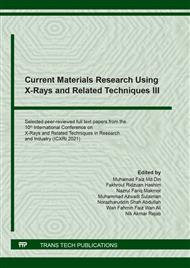[1]
H. Yan, B. Li, Z. Yu, W. Chu, D. Xia, First-Principles Study: Tuning the Redox Behavior of Lithium-Rich Layered Oxides by Chlorine Doping, J. Phys. Chem. C. 121 (2017) 7155–7163.
DOI: 10.1021/acs.jpcc.7b01168
Google Scholar
[2]
Y. Ding, Z.P. Cano, A. Yu, J. Lu, Z. Chen, Automotive Li-Ion Batteries: Current Status and Future Perspectives, Electrochem. Energy Rev. 2 (2019) 1–28.
DOI: 10.1007/s41918-018-0022-z
Google Scholar
[3]
A. Bhandari, J. Bhattacharya, R.G.S. Pala, Adsorption Preference of HF over Ethylene Carbonate Leads to Dominant Presence of Fluoride Products in LiFePO4 Cathode-Electrolyte Interface in Li-Ion Batteries, J. Phys. Chem. C. 124 (2020) 9170–9177.
DOI: 10.1021/acs.jpcc.0c00565
Google Scholar
[4]
J. Hu, W. Huang, L. Yang, F. Pan, Structure and performance of the LiFePO4cathode material: From the bulk to the surface, Nanoscale. 12 (2020) 15036–15044.
DOI: 10.1039/d0nr03776a
Google Scholar
[5]
A.K. Padhi, K.S. Nanjundaswamy, J.B. Goodenough, Phospho-olivines as Positive Electrode Materials for Rechargeable Lithium Batteries, J. Electrochem. Soc. 144 (1997) 1188–1194.
DOI: 10.1149/1.1837571
Google Scholar
[6]
M. Molenda, M. Świętosławski, A. Milewska, M.M. Zaitz, A. Chojnacka, B. Dudek, R. Dziembaj, Carbon nanocoatings for C/LiFePO4 composite cathode, Solid State Ionics. 251 (2013) 47–50.
DOI: 10.1016/j.ssi.2013.03.003
Google Scholar
[7]
J. Zhou, B.H. Liu, Z.P. Li, Nanostructure optimization of LiFePO4/carbon aerogel composites for performance enhancement, Solid State Ionics. 244 (2013) 23–29.
DOI: 10.1016/j.ssi.2013.05.003
Google Scholar
[8]
F.W. Badrudin, M.F.M. Taib, R.I.P.R. Mustapha, O.H. Hassan, M.Z.A. Yahya, Effects of Vanadium Substitution in the Layered LiFeSO4OH: A First Principles Investigation, Mater. Today Proc. 4 (2017) 5108–5115.
DOI: 10.1016/j.matpr.2017.05.015
Google Scholar
[9]
X. Wu, F. Kang, W. Duan, J. Li, Density functional theory calculations: A powerful tool to simulate and design high-performance energy storage and conversion materials, Prog. Nat. Sci. Mater. Int. 29 (2019) 247–255.
DOI: 10.1016/j.pnsc.2019.04.003
Google Scholar
[10]
Stewart J. Clark, M.D. Segall, C.J. Pickard, P.J. Hasnip, M.I.J. Probert, K. Refson, M.C. Payne, First principles methods using CASTEP, Zeitschrift Für Krist. 220 (2005) 567.
DOI: 10.1524/zkri.220.5.567.65075
Google Scholar
[11]
J.P. Perdew, K. Burke, M. Ernzerhof, Generalized Gradient Approximation Made Simple, Phys. Rev. Lett. 77 (1996) 3865–3868.
DOI: 10.1103/physrevlett.77.3865
Google Scholar
[12]
J.P. Perdew, A. Ruzsinszky, G.I. Csonka, O.A. Vydrov, G.E. Scuseria, L.A. Constantin, X. Zhou, K. Burke, Restoring the Density-Gradient Expansion for Exchange in Solids and Surfaces, Phys. Rev. Lett. 100 (2008) 136406.
DOI: 10.1103/physrevlett.102.039902
Google Scholar
[13]
H.J. Monkhorst, J.D. Pack, Special points for Brillouin-zone integrations, Phys. Rev. B. 13 (1976) 5188–5192.
DOI: 10.1103/physrevb.13.5188
Google Scholar
[14]
J. Jung, M. Cho, M. Zhou, Ab initio study of the fracture energy of LiFePO4/FePO4 interfaces, J. Power Sources. 243 (2013) 706–714.
DOI: 10.1016/j.jpowsour.2013.06.030
Google Scholar
[15]
H. Lin, Y. Wen, C. Zhang, L. Zhang, Y. Huang, B. Shan, R. Chen, A GGA+U study of lithium diffusion in vanadium doped LiFePO4, Solid State Commun. 152 (2012) 999–1003.
DOI: 10.1016/j.ssc.2012.03.027
Google Scholar
[16]
C. Loschen, J. Carrasco, K.M. Neyman, F. Illas, First-principles LDA+U and GGA+U study of cerium oxides: Dependence on the effective U parameter, Phys. Rev. B - Condens. Matter Mater. Phys. 75 (2007) 35115.
DOI: 10.1103/physrevb.84.199906
Google Scholar
[17]
M. Aydinol, A. Kohan, G. Ceder, K. Cho, J. Joannopoulos, Ab initio study of lithium intercalation in metal oxides and metal dichalcogenides, Phys. Rev. B - Condens. Matter Mater. Phys. 56 (1997) 1354–1365.
DOI: 10.1103/physrevb.56.1354
Google Scholar
[18]
F.W. Badrudin, M.F.M. Taib, O.H. Hassan, M.Z.A. Yahya, Effect of lithium intercalation on the structural and electronic properties of layered LiFeSO4OH and layered FeSO4OH using first-principle calculations, Comput. Mater. Sci. 119 (2016) 144–151.
DOI: 10.1016/j.commatsci.2016.03.042
Google Scholar
[19]
S. Laref, A. Laref, Theoretical insight into the strain effect on the intercalation potential of Li-FePO4 materials, RSC Adv. 5 (2015) 35667–35674.
DOI: 10.1039/c5ra00045a
Google Scholar
[20]
F. Zhou, M. Cococcioni, K. Kang, G. Ceder, The Li intercalation potential of LiMPO4 and LiMSiO4 olivines with M = Fe, Mn, Co, Ni, Electrochem. Commun. 6 (2004) 1144–1148.
DOI: 10.1016/j.elecom.2004.09.007
Google Scholar
[21]
Y. Okuno, K. Ushirogata, K. Sodeyama, G. Shukri, Y. Tateyama, Structures, Electronic States, and Reactions at Interfaces between LiNi 0.5 Mn 1.5 O 4 Cathode and Ethylene Carbonate Electrolyte: A First-Principles Study, J. Phys. Chem. C. 123 (2019) 2267–2277.
DOI: 10.1021/acs.jpcc.8b10625
Google Scholar
[22]
S. Shi, L. Liu, C. Ouyang, D.S. Wang, Z. Wang, L. Chen, X. Huang, Enhancement of electronic conductivity of LiFePO4 by Cr doping and its identification by first-principles calculations, Phys. Rev. B - Condens. Matter Mater. Phys. 68 (2003) 1951081–1951085.
DOI: 10.1103/physrevb.68.195108
Google Scholar
[23]
Y.-N. Xu, S.-Y. Chung, J.T. Bloking, Y.-M. Chiang, W.Y. Ching, Electronic Structure and Electrical Conductivity of Undoped LiFePO4, Electrochem. Solid-State Lett. 7 (2004) A131–A134.
DOI: 10.1149/1.1703470
Google Scholar
[24]
P. Tang, N.A.W. Holzwarth, Electronic structure of FePO4, LiFePO4, and related materials, Phys. Rev. B. 68 (2003) 165107.
Google Scholar
[25]
C. Frayret, A. Villesuzanne, N. Spaldin, E. Bousquet, J.-N. Chotard, N. Recham, J.-M. Tarascon, LiMSO4F (M = Fe, Co and Ni): promising new positive electrode materials through the DFT microscope., Phys. Chem. Chem. Phys. 12 (2010) 15512–22.
DOI: 10.1039/c0cp00517g
Google Scholar
[26]
T. Tsevelmaa, D. Odkhuu, O. Kwon, S. Cheol Hong, A first-principles study of magnetism of lithium fluorosulphate LiFeSO4F, J. Appl. Phys. 113 (2013) 17B302.
DOI: 10.1063/1.4794723
Google Scholar
[27]
A.K. Padhi, V. Manivannan, J.B. Goodenough, Tuning the Position of the Redox Couples in Materials with NASICON Structure by Anionic Substitution, J. Electrochem. Soc. 145 (1998) 1518–1520.
DOI: 10.1149/1.1838513
Google Scholar
[28]
D.-H. Seo, Y.-U. Park, S.-W. Kim, I. Park, R. a. Shakoor, K. Kang, First-principles study on lithium metal borate cathodes for lithium rechargeable batteries, Phys. Rev. B. 83 (2011) 205127.
DOI: 10.1103/physrevb.83.205127
Google Scholar
[29]
F. Zhou, K. Kang, T. Maxisch, G. Ceder, D. Morgan, The electronic structure and band gap of LiFePO4 and LiMnPO4, Solid State Commun. 132 (2004) 181–186.
DOI: 10.1016/j.ssc.2004.07.055
Google Scholar


